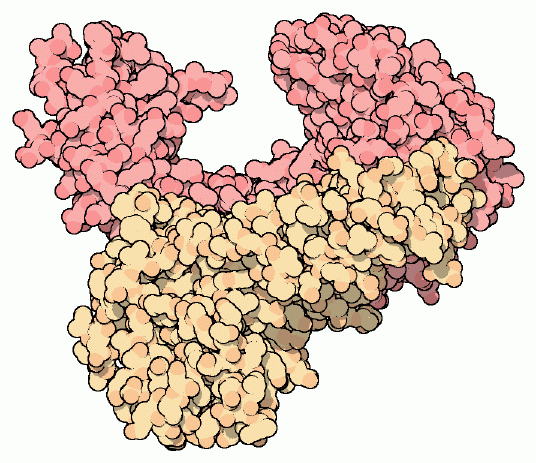|
Inhaltsübersicht | Nanomaschinen | Moleküle | Programme | Kurse | Fun | Links |
||
| > |
Reverse Transcriptase

Viruses are tricky. They use all sorts of unusual mechanisms during their attacks on cells. HIV is no exception. It is a retrovirus, which means that it has the ability to insert its genetic material into the genome of the cells that it infects. But, infectious HIV particles carry their genome in RNA strands. Somehow, during infection, the virus needs to make a DNA copy of its RNA genome. This is very unusual, because all of the normal cellular machinery is designed to make RNA copies from DNA, but not the reverse. DNA is normally only created using other DNA strands as a template. This tricky reversal of synthesis is performed by the enzyme reverse transcriptase, shown here from PDB entry 3hvt. Inside its large, claw-shaped active site, it copies the HIV RNA and creates a double-stranded DNA version of the viral genome. This then integrates into the cell's DNA, and later instructs the cell to make additional copies of the virus.
Tiny Genomes
Viruses are tiny. They only carry enough genetic material to encode a few proteins. Many viruses, such as poliovirus and rhinovirus, carry the bare minimum--just enough to specify their own structure and get synthesis started once they get inside cells. The genome of HIV, on the other hand, carries instructions for building a few enzymes that are used in the reproduction of the virus. Reverse transcriptase is one of these enzymes. But, space in the HIV genome is still at a premium, so reverse transcriptase is encoded in a tricky way. It is composed of two different subunits, but both are encoded by the same gene. After the protein is made, one of the subunits is clipped to a smaller size (shown in yellow here) so that it can form the proper mate with one full-sized subunit (shown in red).A Sloppy Enzyme
Reverse transcriptase performs a remarkable feat, reversing the normal flow of genetic information, but it is rather sloppy in its job. The polymerases used to make DNA and RNA in cells are very accurate and make very few mistakes. This is essential because they are the caretakers of our genetic information, and mistakes may be passed on to our offspring. Reverse transcriptase, on the other hand, makes lots of mistakes, up to about one in every 2,000 bases that it copies (if this same error rate occurred in the "Molecule of the Month," there would be two typos in this month's installment). You might think that this would cause severe problems. But, in fact, this high error rate turns out to be an advantage for the virus in this era of drug treatment. The errors allow HIV to mutate rapidly, finding drug resistant strains in a matter of weeks after treatment begins. Fortunately, the recent development of treatments that combine several drugs are often effective in combating this problem. Since the virus is simultaneously attacked by several different drugs, it cannot mutate to evade all of them at the same time.Next: Two Enzymes in One
Last changed by: A.Honegger,